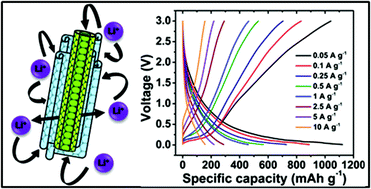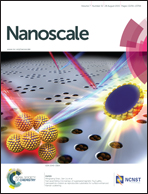Enhanced electrochemical performance by unfolding a few wings of graphene nanoribbons of multiwalled carbon nanotubes as an anode material for Li ion battery applications†
Abstract
The present work provides an incredible route towards achieving the ideal Li ion battery anode material with high specific capacity and rate capability as a result of unraveling a few upper layers of multiwalled carbon nanotubes (MWNTs) as graphene nanoribbons attached to the core MWNT. These partially exfoliated nanotubes when used as an anode material show an 880 mA h g−1 capacity at a 100 mA g−1 current density and high rate capability by delivering a stable 157 mA h g−1 capacity at a current density of 10 A g−1. The enhanced performance of this anode material can be attributed to the synergistic effect of the homogeneous distribution of the hybrid carbon nanostructure of 1-D multiwalled carbon nanotubes and 2-D graphene nanoribbons. This configuration provides a large available surface area, high electrical conductivity and a high number of defect sites, leading to improved Li intercalation with a better transfer rate compared to only graphene, multiwalled carbon nanotubes or other reported combinations of the two.


 Please wait while we load your content...
Please wait while we load your content...